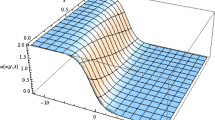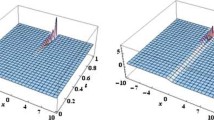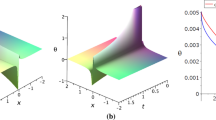Abstract
In this article, Kudryashov and modified Kudryashov techniques were implemented to acquire new exact solutions of the time fractional (2+1)-dimensional CBS equation. The solutions thus attained have been stated explicitly and graphical models have been illustrated by choosing appropriate values to the parameters to visualize the mechanism of the considered nonlinear fractional differential equation (FDE). The considered methods are very powerful and effective enough to utilize for establishing solutions of various nonlinear FDEs applied in mathematical physics.
Access provided by Autonomous University of Puebla. Download conference paper PDF
Similar content being viewed by others
Keywords
- Conformable fractional derivative
- Fractional Calogero–Bogoyavlenskii–Schiff (CBS) equation
- Generalized Kudryashov method
- Modified Kudryashov method
1 Introduction
In present century, fractional calculus has been established as a vibrant field of study in engineering and science, as many researchers are paying interest to it due to its diversified implementation in various fields like heat transfer, signal processing, biology, robotics, electronics, genetic algorithms, control systems, etc. Many mathematical models are governed by fractional order differential equations. These ideas were attributed to Leibniz, Liouville, Riemann, Caputo, etc. The basic literature related to fractional derivatives and integrals is discussed in refs [1, 2].
In examining the physical phenomena, the study of nonlinear FDEs executes a significant role. Various methods have already been implemented to attain exact solutions of FPDEs [3,4,5]. Few distinguished efforts have been noticed by the scientists for analyzing FDEs arising in mathematical physics. In this manuscript, the conformal time fractional CBS equation has been contemplated for the first time.
Consider the conformable time fractional (2+1)-dimensional CBS equation
where \(\alpha\) denotes the order of conformable derivative. Bogoyavlenskii constructed the CBS equation by utilizing the modified Lax formalism [6, 7]. Later, it was derived by Schiff [8] using self-dual Yang Mills equation. The fundamental interaction of a Riemann wave along the y-axis with a long wave along the x-axis is governed by the CBS equation.
Methods such as Cole Hopf transformation [9], singular manifold method [10, 11], similarity transformations method [12], the Tanh–Coth method [13], the Tanh function method [14], the improved Tanh–Coth method [15], sine–cosine approach [16], the extended homoclinic test approach [17], Hirota’s bilinear method [18], and the Lie transformation method [10, 19] had been employed to acquire solutions of CBS equation. But the extensive study of conformable time fractional CBS equation is just the opening.
The acquired exact solutions for fractional (2+1)-dimensional CBS equation have been documented first time ever in this manuscript.
This paper is systematized as follows. In Sect. 2, introduction to conformable fractional derivative has been provided. The algorithm of generalized Kudryashov and modified Kudryashov technique is provided in Sect. 3. The Kudryashov techniques have been implemented to fractional CBS equation which is discussed in Sect. 4. In Sect. 5, results are furnished, and Sect. 6 concludes the article.
2 Conformable Fractional Derivative
The conformable fractional derivative of a function \(u\left( t \right)\) of order \(\alpha\) is defined by [20,21,22]
Some properties of conformal fractional derivatives are as follows [22]
-
(i)
\(T_\alpha \left( {au + bv} \right) = aT_\alpha \left( u \right) + bT_\alpha \left( v \right)\).
-
(ii)
\(T_\alpha \left( {t^\mu } \right) = \mu t^{\mu - \alpha } ,{\text{for all}}\,\mu \in \rm{\mathbb{R}}\).
-
(iii)
\(T_\alpha \left( {u*v} \right)\left( t \right) = t^{1 - \alpha } v^{\prime}\left( t \right)u^{\prime}(v(t))\).
3 Algorithm of the Proposed Method
The generalized Kudryashov and modified Kudryashov techniques have been employed to calculate the exact solutions of fractional (2+1)-dimensional CBS equations. A number of researchers have demonstrated the generalization, reliability, and efficacy of this approach [23, 24]. The basic ideas of generalized Kudryashov and modified Kudryashov methods are discussed in Refs. [22, 25, 26].
4 Exact Solution of Time Fractional (2+1)-Dimensional CBS Equation
This segment consists of the solutions of time fractional (2+1)-dimensional CBS equations by utilizing the generalized Kudryashov and modified Kudryashov techniques to calculate the exact solution for the same.
4.1 Application of Generalized Kudryashov Technique
By utilizing the wave transformation [27] \(u\left( {x,y,t} \right) = U\left( \xi \right)\), \(\xi = x + y - \lambda \left( {\frac{t^\alpha }{\alpha }} \right)\), Eq. (1.1) can be reduced as
where \(\lambda\) is the constant that is to be evaluated later. Now, the value of N is found to be 1 by equating the nonlinear term and highest order derivative term of Eq. (4.1).
Therefore,
where \(\psi \left( \xi \right) = \frac{1}{1 \pm e^\xi }\).
\(\varphi_0 , \varphi_1\) are constants to be determined.
Next, system of algebraic equations was acquired from Eq. (4.2), substituting the derivatives of \(U\left( \xi \right)\) and considering the ansatz. The same powers of \(\psi^i , \left( {i = 1, 2, 3, \ldots } \right)\) are collected and equate to zero, to acquire the following system of nonlinear equations:
Coefficient of \(\psi^1\):
Coefficient of \(\psi^2\):
Coefficient of \(\psi^3\):
Coefficient of \(\psi^4 :\)
Coefficient of \(\psi^5\):
On solving Eqs. (4.3)–(4.7), the following nontrivial solutions can be acquired.
Case I: For \(\varphi_1 = 2, \lambda = 1\) and \(\psi\left( \xi \right) = \frac{1}{1 + e^\xi }\), the new exact solution of the conformable time fractional CBS equation given in Eq. (1.1) can be identified as
Case II: For \(\varphi_1 = 2, \lambda = 1\) and \(\psi \left( \xi \right) = \frac{1}{1 - e^\xi }\), the exact solution of Eq. (1.1) is given by
4.2 Application of Modified Kudryashov Technique
Equation (4.2) can be attained in the aforementioned manner. Next, considering the ansatz \(\psi \left( \xi \right) = \frac{1}{1 \pm a^\xi }\) in Eq. (4.2) and substituting the derivatives of \(U\left( \xi \right)\) in Eq. (4.1), the following equations can be acquired.
Coefficient of \(\psi^1\):
Coefficient of \(\psi^2\):
Coefficient of \(\psi^3\):
Coefficient of \(\psi^4 :\)
Coefficient of \(\psi^5\):
On solving Eqs. (4.10)–(4.14), the following nontrivial solutions can be attained.
Case I: For \(\varphi_1 = 2\ln \left( a \right),\lambda = \left( {{\text{ln}}\left( a \right)} \right)^2\) and \(\psi \left( \xi \right) = \frac{1}{1 + a^\xi }\), the new exact solution of the conformable time fractional CBS equation given in Eq. (1.1) can be identified as
Case II: For \(\varphi_1 = 2\ln \left( a \right),\lambda = \left( {{\text{ln}}\left( a \right)} \right)^2\) and \(\psi \left( \xi \right) = \frac{1}{1 - a^\xi }\), the exact solution of Eq. (1.1) is given by
5 Results
The exact solutions of conformable time fractional (2+1)-dimensional CBS equation have been attained for the first time by employing the generalized Kudryashov and modified Kudryashov techniques with the aid of wave transform. The following 3D graphical models of the obtained solutions \(u\left( {x,y,t} \right)\) have been illustrated in Figs. 1, 2, 3, 4, 5, 6, 7, and 8 for various values \(\alpha\) and by choosing appropriate values to the parameters.
3D plot of \(u_1 \left( {x,y,t} \right)\) for time fractional CBS equation given in Eq. (4.8) when \(\varphi_0 = 1, y = 1,\) at (i) \(\alpha = 0.25\), (ii) \(\alpha = 0.5\)
3D plot of \(u_1 \left( {x,y,t} \right)\) for time fractional CBS equation given in Eq. (4.8) when \(\varphi_0 = 1, y = 1,\) at (i) \(\alpha = 0.75\), (ii) \(\alpha = 1\)
3D plot of \(u_2 \left( {x,y,t} \right)\) for time fractional CBS equation given in Eq. (4.9) when \(\varphi_0 = 1, y = 1,\) at (i) \(\alpha = 0.25\), (ii) \(\alpha = 0.5\)
3D plot of \(u_2 \left( {x,y,t} \right)\) for time fractional CBS equation given in Eq. (4.9) when \(\varphi_0 = 1, y = 1,\) at (i) \(\alpha = 0.75\), (ii) \(\alpha = 1\)
3D plot of \(u_3 \left( {x,y,t} \right)\) for time fractional CBS equation given in Eq. (4.15) when \(\varphi_0 = 1, y = 1, a = 2\) at (i) \(\alpha = 0.25\), (ii) \(\alpha = 0.5\)
3D plot of \(u_3 \left( {x,y,t} \right)\) for time fractional CBS equation given in Eq. (4.15) when \(\varphi_0 = 1, y = 1, a = 2\) at (i)\(\alpha = 0.75\), (ii) \(\alpha = 1\)
3D plot of \(u_4 \left( {x,y,t} \right)\) for time fractional CBS equation given in Eq. (4.16) when \(\varphi_0 = 1, y = 1, a = 2\) at (i)\(\alpha = 0.25\), (ii) \(\alpha = 0.5\)
3D plot of \(u_4 \left( {x,y,t} \right)\) for time fractional CBS equation given in Eq. (4.16) when \(\varphi_0 = 1, y = 1, a = 2\) at (i)\(\alpha = 0.75\), (ii) \(\alpha = 1\)
6 Conclusion
Here, the solitary wave solutions of conformable time fractional (2+1)-dimensional CBS equations are investigated. The generalized Kudryashov and modified Kudryashov techniques have successfully implemented to formally derive these solutions. To visualize the mechanism of fractional CBS equation, the graphs of the acquired solutions are furnished by selecting suitable values to the parameters. This discourse evident that the focused methods are efficacious for analytical solutions of higher order FDEs. It can also be manifested that the methods are thoroughly dependable and significant to discover new exact solutions.
References
Podlubny I (1999) Fractional differential equations. Academic Press, New York, USA
Das S (2011) Functional fractional calculus. Springer, New York
Saha Ray S, Gupta AK (2018) Wavelet methods for solving partial differential equations and fractional differential equations. CRC Press, Boca Raton
Gupta AK, Saha Ray S (2017) On the solitary wave solution of fractional Kudryashov-Sinelshchikov equation describing nonlinear wave processes in a liquid containing gas bubbles. Appl Math Comput 298:1–12
Saha Ray S (2017) On conservation laws by Lie symmetry analysis for (2+1)-dimensional Bogoyavlensky-Konopelchenko equation in wave propagation. Comput Math Appl 74(6):1158–1165
Bogoyavlenskii OI (1990) Overturning solitons in new two dimensional integrable equations. Math USSR-Izvestiya 34(2):245–259
Bogoyavlenskii OI (1990) Breaking solitons in (2+1)-dimensional integrable equations. Russ Math Surv 45:1–86
Calogero F (1995) Integrable nonlinear evolution equations and dynamical systems in multidimensions. Acta Appl Math 39:229–244. https://doi.org/10.1007/BF00994635
Wazwaz AM (2010) The (2+1) and (3+1) dimensional CBS equations: multiple soliton solutions and multiple singular soliton solutions. Zeitschrift für Naturforschung 65(a):173–181
Peng Y, Shen M (2006) On exact solutions of the Bogoyavlenskii equation. J Phys 67(3):449–456
Saleh R, Kassem M, Mabrouk S (2017) Exact solutions of Calgero-Bogoyavlenskii-Schiff equation using the singular manifold method after Lie reductions. Math Meth Appl Sci 40(16):5851–5862
Kumar R (2016) Application of Lie-group theory for solving Calogero-Bogoyavlenskii-Schiff equation. IOSR J Math 12:144–147
Wazwaz AM (2008) New solutions of distinct physical structures to high-dimensional nonlinear evolution equations. Appl Math Comput 196:363–370
Moatimid G, El-Shiekh R, Abdul-Ghani AN (2013) Exact solutions for Calogero-Bogoyavlenskii-Schiff equation using symmetry method. Appl Math Comput 220:455–462
Gomez C (2015) Exact solution of the Bogoyavlenskii equation using the improved Tanh-Coth method. Appl Math Sci 9:4443–4447
Najafi M, Arbabi S, Najafi M (2012) New exact solutions of (2+1) dimensional Bogoyavlenskii equation by the sine-cosine method. Int J Basic Appl Sci 1(4):490–497
Darvishi M, Najafi M, Najafi M (2010) New application of EHTA for the generalized (2+1) dimensional nonlinear evolution equations. World Acad Sci Eng Technol 37:494–500
Wazwaz AM (2008) Multiple-soliton solutions for the Calogero-Bogoyavlenskii-Schiff, Jimbo-Miwa and YTSF equations. Appl Math Comput 203:592–597
Gandarias M, Bruzon M (2008) Travelling wave solutions for a CBS equation in (2+1) dimensions. In: Proceedings of American conference on applied mathematics. World Scientific and Engineering Academy and Society, Harvard, pp 153–158
Khalil R, Al-Horani M, Yousefi A, Sababheh M (2014) A new definition of fractional derivative. J Comput Appl Math 264:65–70
Abdeljawad T (2015) On conformable fractional calculus. J Comput Appl Math 279:57–66
Hosseini K, Bekir A, Ansari R (2017) New exact solutions of the conformable time-fractional Cahn-Allen and Cahn-Hilliard equations using the modified Kudryashov method. Optik 132:203–209
Kudryashov NA (2009) On new travelling wave solutions of the KdV and the KdV-Burgers equation. Commun Nonlinear Sci Numer Simul 14:1891–1900
Ryabov PN, Sinelshchikov DI, Kochanov MB (2011) Application of the Kudryashov method for finding exact solutions of the high order nonlinear evolution equations. Appl Math Comput 218:3965–3972
Gupta AK (2019) On the exact solution of time-fractional (2+1) dimensional Konoplechenko-Dubrovsky equation. Int J Appl Comput Math 5. https://doi.org/10.1007/s40819-019-0678-z
Hosseini K, Mayeli P, Ansari R (2017) Modified Kudryashov method for solving the conformable time-fractional Klein-Gordon equations with quadratic and cubic nonlinearities. Optik-Int J Light Electron Opt 130:737–742
Hosseini K, Ansari R (2017) New exact solutions of nonlinear conformable time-fractional Boussinesq equations using the modified Kudryashov method. Waves Random Complex Media 27(4):628–636
Author information
Authors and Affiliations
Corresponding author
Editor information
Editors and Affiliations
Rights and permissions
Copyright information
© 2022 The Author(s), under exclusive license to Springer Nature Singapore Pte Ltd.
About this paper
Cite this paper
Sahoo, A.K., Gupta, A.K. (2022). New Analytical Exact Solutions of Time Fractional (2+1)-Dimensional Calogero–Bogoyavlenskii–Schiff (CBS) Equations. In: Ray, S.S., Jafari, H., Sekhar, T.R., Kayal, S. (eds) Applied Analysis, Computation and Mathematical Modelling in Engineering. AACMME 2021. Lecture Notes in Electrical Engineering, vol 897. Springer, Singapore. https://doi.org/10.1007/978-981-19-1824-7_7
Download citation
DOI: https://doi.org/10.1007/978-981-19-1824-7_7
Published:
Publisher Name: Springer, Singapore
Print ISBN: 978-981-19-1823-0
Online ISBN: 978-981-19-1824-7
eBook Packages: Mathematics and StatisticsMathematics and Statistics (R0)












